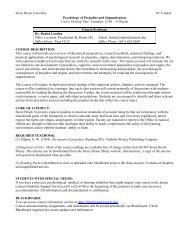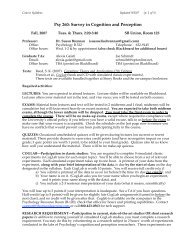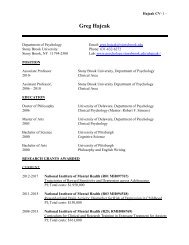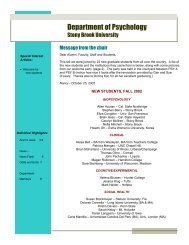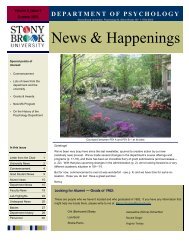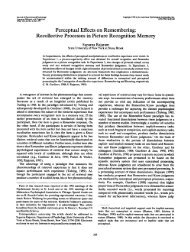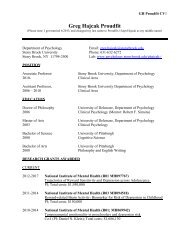Computer-Mediated Communication: A Cognitive Science Approach
Computer-Mediated Communication: A Cognitive Science Approach
Computer-Mediated Communication: A Cognitive Science Approach
Create successful ePaper yourself
Turn your PDF publications into a flip-book with our unique Google optimized e-Paper software.
Article Number: LALI: 00861<br />
4 <strong>Computer</strong>-<strong>Mediated</strong> <strong>Communication</strong>: A <strong>Cognitive</strong> <strong>Science</strong> <strong>Approach</strong><br />
t0005 Table 1 Affordances of <strong>Communication</strong> Media<br />
Media<br />
Affordances of Media<br />
Faceto-face<br />
Video<br />
conference<br />
Telephone<br />
Instant<br />
messaging or<br />
chat<br />
E-<br />
mail<br />
p0075<br />
(1) Physical co-presence: Participants share a physical environment,<br />
þþ ??<br />
including a view of what each is doing and looking at.<br />
(2) Visibility: One participant sees another, but not necessarily what the other þþ þ<br />
is doing or looking at.<br />
(3) Audibility: One participant can hear another. þþ þþ þþ<br />
(4) Cotemporality: Messages are received without delay (close to the time þþ ?? þþ ??<br />
that they are produced and directed at addressees), permitting finegrained<br />
interactivity.<br />
(5) Simultaneity: Participants can send and receive messages at the same þþ ?? þþ ??<br />
time, allowing communication in parallel.<br />
(6) Sequentiality: Participants take turns in an orderly fashion in a single þþ þþ þþ<br />
conversation at a time; one turn’s relevance to another is signaled by<br />
adjacency.<br />
(7) Reviewability: Messages do not fade over time. þþ þþ<br />
(8) Revisability: Messages can be revised before being sent. þþ þþ<br />
a<br />
Present in a particular medium: þþ; present to a limited extent: þ; present in some systems: ??; absent: . Physical co-presence (1),<br />
the hallmark of face-to-face communication, nearly always includes affordances (2) through (5).<br />
Adapted from Clark & Brennan, 1991.<br />
In closing, the grounding framework is a usefulvantage<br />
point from which to view, understand, and<br />
predict the effects of new media upon communication.<br />
The abundance and portability of new communication<br />
programs and devices (PDAs, added cell<br />
phone functionality such as digital photography,<br />
more extensive wireless networks, unobtrusive<br />
methods for eye-tracking, multimedia Internet content,<br />
etc.) will continue to make it even easier for<br />
mediaphiles to switch mid-conversation from one<br />
medium to another, as in our opening example of<br />
Calion’s e-mail invitation to Aisha. Recently the New<br />
York Times chronicled a man and his BlackBerry (a<br />
portable wireless device for e-mail and instant messaging):<br />
‘‘He once saw a romantic interest walk into a<br />
bar and immediately called her on her cell phone. ‘I<br />
saw her look at the phone and put me right to voice<br />
mail,’ he said, still indignant. But then he sent her a<br />
BlackBerry message, which made her laugh and<br />
prompted her to walk over and find him.’’ The ability<br />
to spontaneously switch media within the same conversation<br />
enables increasingly flexible and innovative<br />
techniques for grounding.<br />
See also: <strong>Computer</strong>-mediated communication (00703);<br />
Context and common ground (01088); Dialogue and Interaction<br />
(00792); E-mail, Internet, Chatroom talk, pragmatics<br />
of (00377); Multimodal Interaction with computers<br />
(04362); Pauses and Hesitations: A psycholinguistic approach<br />
(00796); Psycholinguistics: Overview (00788).<br />
Bibliography<br />
Anderson A H, Smallwood L & MacDonald R (2000).<br />
‘Video data and video links in mediated communication:<br />
What do users value?’ International Journal of Human-<br />
<strong>Computer</strong> Studies 52, 165–187.<br />
Brennan S E (1990). Seeking and providing evidence for<br />
mutual understanding.’ Unpublished doctoral dissertation,<br />
Stanford University, Stanford, CA.<br />
Brennan S E (1998). ‘The grounding problem in conversation<br />
with and through computers.’ In Fussell S R & Kreuz<br />
R J (eds.) Social and cognitive psychological approaches<br />
to interpersonal communication. Hillsdale, NJ: Erlbaum.<br />
201–225.<br />
Brennan S E (2004). ‘How conversation is shaped by visual<br />
and spoken evidence.’ In Trueswell J & Tanenhaus M<br />
(eds.) World situated language use: Psycholinguistic, linguistic,<br />
and computational perspectives on bridging the<br />
product and action traditions. Cambridge, MA: MIT<br />
Press.<br />
Brennan S E & Lockridge C B (2004). ‘Monitoring an<br />
addressee’s visual attention: Effects of visual co-presence<br />
on referring in conversation.’ Unpublished manuscript.<br />
Brennan S E & Ohaeri J O (1999). ‘Why do electronic<br />
conversations seem less polite? The costs and benefits of<br />
hedging.’ Proceedings, International Joint Conference on<br />
Work Activities, Coordination, and Collaboration<br />
(WACC ’99). San Francisco, CA: ACM. 227–235.<br />
Chapanis A, Ochsman R & Parrish R (1972). ‘Studies<br />
in interactive communication I: The effects of four<br />
communication modes on the behavior of teams<br />
during cooperative problem solving.’ Human Factors<br />
14, 487–509.<br />
FIRST PROOF



